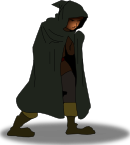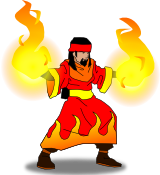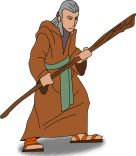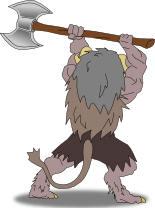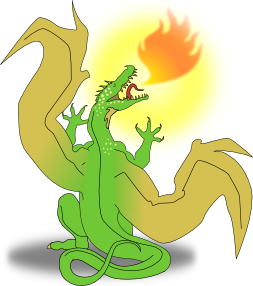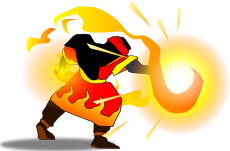Difference between revisions of "Mini mam"
(→Character Development) |
BFGalbraith (talk | contribs) m (Updated by BFGalbraith in anticipation of a new upcoming post-Squawk mano a mano update.) |
||
| (85 intermediate revisions by 4 users not shown) | |||
| Line 1: | Line 1: | ||
| − | Mini mam is | + | Mini mam is designed to recreate the feel of generic fantasy role-playing with a minimum set of rules. Feel free use these rules and modify them as you see fit under the terms of the Creative Commons Attribution-ShareAlike license. (Mini mam is named after older versions of the [[Mano a Mano]] Role-Playing System. MiniMaM eventually led to the creation of the [http://knol.google.com/k/scratch-rps Scratch RPS].) |
==Players== | ==Players== | ||
| Line 8: | Line 8: | ||
These are the essential rules that at least one player should have more-or-less memorized, so the game can be played without looking at the written rules. Only the most critical and essential rules are included in the Core Rules section. | These are the essential rules that at least one player should have more-or-less memorized, so the game can be played without looking at the written rules. Only the most critical and essential rules are included in the Core Rules section. | ||
| + | |||
| + | ===Abilities=== | ||
| + | |||
| + | ;Thievery: This ability gives a +1 bonus to ''escaping'' (+1 defense while fleeing), ''backstabbing'' (+1 to attack fleeing characters), ''hiding'' before combat and rolls involving sneaky deeds like lying, finding secret doors and cheating at games. Characters with this ability can pick locks and disarm traps. | ||
| + | |||
| + | :Characters with thievery have an ''initiative'' advantage: they always get their combat turns before characters without the ability on either team. On their first turn in each battle, a character with this ability can do a ''sneak attack'' which will make even a healthy character incapacitated if it is successful. | ||
| + | |||
| + | ;Magic: Magic is used to destroy or disable enemies in combat. Any time a character with this ability can do a normal attack, he can instead cast a ''fireball'' spell which will make even a healthy character incapacitated if it is successful. (Instead of a fireball the character could cast some other spell which has the same effect.) Characters with this ability also have a +1 to any rolls requiring knowledge of magical things. | ||
| + | |||
| + | ;Fighting: Fighting ability reflects a warrior's physical strength and skill with armor and weapons. A character with this ability has a +1 bonus to combat rolls when ''attacking'' or ''defending'', as well as any rolls which require strategy or combat-related knowledge. | ||
| + | |||
| + | ;Healing: Healers help keep their allies fighting, significantly improving the odds of victory. A character with this ability can ''revive'' a character who is incapacitated so that they are only injured or ''heal'' a character who is injured so that they are healthy. They also have a +1 modifier to rolls that require people skills like persuasion. | ||
===Characters=== | ===Characters=== | ||
| − | Each character | + | {| width="100%" |
| + | | valign="top" | | ||
| + | Each character controlled by a player is usually<br> | ||
| + | a rogue, warrior, wizard or priest with one ability: | ||
| + | {| width="100%" | ||
| + | | height="30" | || | ||
| + | |- | ||
| + | | valign="bottom" | [[Image:Minimam-rogue-healthy.png]] | ||
| − | + | The '''Rogue''' is a sneaky<br> | |
| − | + | character with the ''thievery''<br> | |
| − | + | ability, like a spy, burglar,<br> | |
| − | + | scout or assassin. | |
| − | + | | valign="bottom" | [[Image:Minimam-wizard-healthy.png]] | |
| − | |||
| − | + | The '''Wizard''' uses powerful<br> | |
| + | ''magic'' to destroy the enemy. | ||
| + | |- | ||
| + | | height="60" | || | ||
| + | |- | ||
| + | | valign="bottom" | [[Image:Minimam-warrior-healthy.png]] | ||
| − | + | The '''Warrior''' has <br> | |
| + | ''fighting'' ability. | ||
| + | | valign="bottom" | [[Image:Minimam-priest-healthy.png]] | ||
| − | Level | + | The '''Priest''' supports<br> |
| − | + | allies with ''healing'' ability. | |
| − | + | |} | |
| − | + | | valign="top"| | |
| − | + | [[Image:Minimam-monster-healthy.png]] | |
| − | + | ||
| − | + | An ordinary '''Monster''' (possibly a<br> | |
| + | horrible creature, rampaging beast or<br> | ||
| + | wicked person) has no special abilities.<br> | ||
| + | |||
| + | [[Image:Minimam-dragon-healthy.png]] | ||
| + | |||
| + | The ''Dragon'' is a powerful, devious,<br> | ||
| + | magical creature with all four abilities:<br> | ||
| + | ''thievery'', ''magic'', ''fighting'' and ''healing''. | ||
| + | |} | ||
| + | |||
| + | ===Levels=== | ||
| + | |||
| + | Each character also has a ''level'' showing how powerful and accomplished they are. A normal hero starts off at Level 1, but nearly harmless characters, like ordinary villagers and unproven adventurers, start off at level 0. A character can gain a few levels throughout their life span. To gain each level the character needs years of training, a lot of combat experience, and significantly more powerful and rare magical items to become powerful enough to be on the same level as characters on the next level higher. | ||
| + | |||
| + | {| | ||
| + | ! level !! | ||
| + | |- | ||
| + | | align="center" | 0 || Weak, unproven in combat | ||
| + | |- | ||
| + | | align="center" | 1 || Proven capable of self-defense | ||
| + | |- | ||
| + | | align="center" | 2 || Can hold his own with most combatants | ||
| + | |- | ||
| + | | align="center" | 3 || More powerful than most combatants | ||
| + | |- | ||
| + | | align="center" | 4 || Famously powerful (this level is beyond the reach of most characters) | ||
| + | |- | ||
| + | | align="center" | 5 || Legendary | ||
| + | |} | ||
===Rolls=== | ===Rolls=== | ||
| Line 40: | Line 94: | ||
Use the following scale for other difficulty modifiers: | Use the following scale for other difficulty modifiers: | ||
| − | + | {| | |
| − | + | ! difficulty || | |
| − | + | |- | |
| − | + | | align="center" | 0 || relatively easy | |
| − | + | |- | |
| − | + | | align="center" | 1 || a little tricky | |
| − | + | |- | |
| + | | align="center" | 2 || challenging | ||
| + | |- | ||
| + | | align="center" | 3 || very difficult | ||
| + | |- | ||
| + | | align="center" | 4 || rarely done before | ||
| + | |- | ||
| + | | align="center" | 5 || only theoretically possible | ||
| + | |} | ||
===Combat Rounds=== | ===Combat Rounds=== | ||
| − | Each character can do one action each round. The action is usually an attack. The characters have their turns to do actions in the order their players are seated clockwise, starting with the player sitting to the left of the Game Master. | + | Each character can do one action each round. The action is usually an attack. The characters have their turns to do actions in the order their players are seated clockwise, starting with the player sitting to the left of the Game Master. Characters with thievery ability (rogues and dragons) always have their turns before the other characters, then the rest of the characters have their turns to act. (If teams of players are battling each other, the players should be seated so that the members of each team are not grouped together.) If the Game Master's characters successfully sneak up on the other characters, then the Game Master's characters go first instead of the player to his left. |
===Damage=== | ===Damage=== | ||
| − | Characters have three types of '''health''': | + | Characters have three types of '''health''': |
| − | + | {| | |
| + | | width="33%" valign="bottom" | [[Image:Minimam-warrior-healthy.png]] | ||
| + | | width="33%" valign="bottom" | [[Image:Minimam-warrior-injured.png]] | ||
| + | | width="33%" valign="bottom" | [[Image:Minimam-warrior-incapacitated.png]] | ||
| + | |- | ||
| + | | valign="top" | '''healthy''' | ||
| + | |||
| + | If a healthy character is successfully attacked he becomes injured. | ||
| + | | valign="top" | '''injured''' | ||
| + | |||
| + | Injured characters have 1 subtracted from all of their rolls. | ||
| + | If an injured character is successfully attacked he becomes incapacitated. | ||
| + | If an injured character is healed he becomes healthy. | ||
| + | | valign="top" | '''incapacitated''' | ||
| + | |||
| + | Incapacitated characters can't do anything at all. | ||
| + | If an incapacitated character is healed he becomes injured | ||
| + | |} | ||
| + | |||
| + | [[Image:Minimam-wizard-attack.png]] | ||
| + | |||
| + | A successful '''fireball''', similar magic spell or '''sneak attack''' (the first attack of a character with thievery ability) makes the target incapacitated regardless of their previous health. | ||
===Escaping=== | ===Escaping=== | ||
| − | A | + | A character may want to flee rather than fight. This can be achieved two ways. First, before combat begins, a character can attempt to hide from other characters, using character levels added to the rolls (with an additional +1 for characters with thievery ability.) If a character successfully hides from the opposing characters, he does not have to participate in the following combat rounds. |
| − | + | Escaping after combat begins involves two steps: First, on the escaping character's turn, his player says that the character is trying to escape. This is the character's action for that turn. Second, on the escaping character's next turn, he disappears from combat if he has not been successfully attacked since the previous turn. Characters with thievery ability have a +1 bonus to defense rolls while they are trying to escape, and a +1 bonus to attack rolls when attacking a character who is trying to escape. | |
| − | == | + | ==Extra Rules== |
| − | + | Here is a section for adding extra rules that go beyond the absolutely essential "core rules". | |
| − | + | ===Spells=== | |
| − | |||
| − | |||
| − | |||
| − | |||
| − | |||
| − | + | Characters with magic ability can call their "fireball" spell anything they want, as long as it is incapacitating. For example, wizards might call their spell "freeze", "zap" or "choke". They might trap the enemy in a sticky web or turn him into a frog. Dragons might describe their spell as some kind of breath weapon, such as "acidic vomit" or "tear gas." | |
| − | + | ===New Villains=== | |
| − | |||
| − | |||
| − | |||
| − | |||
| − | |||
| − | + | New types of characters can have the same abilities as a monster, rogue, warrior, wizard, priest or dragon. Or you could give them a different combination of abilities. More powerful types of monsters should have higher levels. For example: | |
| − | + | ;Kraken: The Kraken is a giant sea monster. The Kraken is a match for even famous heroes so it would have a level of 3 or 4. The Kraken has no special abilities. | |
| − | + | ;Leprechaun: A leprechaun is a small, clever creature which is difficult to catch. Leprechauns have ''thievery'' ability and usually win contests of stealth and guile. | |
| − | |||
| − | |||
| − | |||
| − | + | ;Lich: A lich is a powerful undead wizard with two abilities: In addition to the ''magic'' ability used to throw fireballs like a living wizard, the lich can raise fallen allies as undead servants like a sort of ''healing'' ability. | |
| − | + | ;Unicorn: A unicorn is one of the most dangerous magical animals. Like the dragon it has all four abilities. It's horn has ''healing'' powers. This is the major reason people hunt unicorns, but the unicorn is clever and hard to catch because of it's ''thievery'' ability. The unicorn is so difficult to deceive that the standard strategy to catch the unicorn requires the use of an innocent girl without guile. The few warriors who have engaged unicorns in physical combat have been easily defeated by the unicorn's ''fighting'' ability often dispatched in a single blow by the ''magic'' horn. | |
| − | === | + | ===New Abilities=== |
| − | + | Some characters might have minor abilities which give them just one aspect of the four basic abilities: | |
| − | + | <dd> | |
| + | '''escaping''' (+1 defense while fleeing)<br> | ||
| + | '''backstabbing''' (+1 to attack fleeing characters)<br> | ||
| + | '''hiding''' (+1 to hide before combat)<br> | ||
| + | '''pick locks''' (can try to pick locks)<br> | ||
| + | '''disarm traps''' (can try to disarm traps)<br> | ||
| + | '''initiative''' (go first in combat like characters with thievery)<br> | ||
| + | '''sneak attack''' (attack on first turn can incapacitate a healthy enemy)<br> | ||
| + | '''fireball''' (just the spell without the magic knowledge)<br> | ||
| + | '''arcane lore''' (just the knowledge without the spell)<br> | ||
| + | '''attacking''' (+1 to attack rolls)<br> | ||
| + | '''defending''' (+1 to defense rolls)<br> | ||
| + | '''revive''' (change an incapacitated ally's health to injured.)<br> | ||
| + | '''heal wounds''' (change an injured ally's health to healthy.)<br> | ||
| + | '''persuasion''' (+1 to people skills) | ||
| + | </dd> | ||
| − | + | Characters could also have abilities which have different effects: | |
| − | + | :'''protection''' ability gives the character uncanny ability to avoid assassination attempts and magical curses. A character with protection ability is injured instead of incapacitated by a successful fireball, other spell or sneak attack. | |
| − | + | :'''explosion''' ability allows a character to cast a spell which hits every enemy in a battle. When the character uses this spell, make an attack roll against every enemy which is not incapacitated. If the roll is successful the enemy is injured if it was healthy and incapacitated if it was injured. Unlike fireball and similar spells, explosion spells do not incapacitate healthy enemies. | |
| − | + | Characters can even have ''disabilities'' that work against them: | |
| − | + | :'''vampirism''' gives the character an unquenchable thirst for blood and an allergy to sunlight, religion and spicy foods. | |
| − | + | :'''unclean abomination''' disability causes the character with the disability to be incapacitated by any successful attack from a character with healing ability, such as a priest, even if the character with this disability is healthy. | |
| − | + | ===Items=== | |
| − | + | Most equipment, such as swords, armor, invisibility cloaks and magic wands simply make characters better at doing the things they can already do. This is reflected in the character's level. However, sometimes characters may have the need or opportunity to use items that enable them to do new things. These might be permanent things the character can use over and over, or they might be items which are only used once. For example: | |
| − | * | + | * a ''flying carpet'' allows a small group of characters to fly |
| − | + | * a ''healing potion'' allows any character to heal like a Priest, but after one use the healing potion is gone | |
| + | * a ''ninja smoke bomb'' is a single-use item which allows a character to escape instantly instead of giving his attackers a chance to catch him. | ||
| + | * a ''protective amulet'' gives the character wearing it the protection ability. | ||
| + | * a ''destruction scroll'' gives the explosion ability to any character with magic ability who studies the scroll for a few days (the character keeps the explosion ability even if they lose the scroll.) | ||
| − | === | + | ===Minions=== |
| − | + | Some villains surround themselves with armies of evil but not particularly powerful minions, which are easy for heroes to kill except for their numbers. Minions are always level 0 and have no special abilities. Minions are even easier to kill than level 0 monsters and villagers with no special abilities: any successful attack against a minion will incapacitate it, even if the minion is not injured. (Other types of character might also have this weakness, like helpless people and small animals.) | |
| − | + | ===Traps=== | |
| − | + | Characters can set traps and ambush their opponents. The characters who set the trap must stay with the trap and wait for their opponents to walk into it, or the trap will have no effect. | |
| − | + | Characters with thievery ability have a chance to detect a trap before walking into it. Roll a die for each character with thievery heading toward the trap and add their level to the result. Roll another die for the trap and add the highest level of any character with thievery ability who helped set the trap to that roll. If the roll for the trap is equal to or greater than the rolls for all of the characters with thievery heading for the trap, then the characters who set the trap and are waiting in ambush get one turn to attack or flee before combat begins normally. | |
| − | + | If any character with thievery heading toward the ambush rolls higher than the roll for the trap, he detects the trap. All of the characters on his side can avoid the trap and the characters waiting in ambush, or they can choose to fight the characters waiting in ambush. When characters detect a trap and avoid it, they don't get to find out how many and what type of enemies were lying in wait. | |
| − | + | ===More Levels=== | |
| − | + | For more gradual character development you can allow higher maximum levels and increase the ability and injury modifiers from +1 or -1 to +3 or -3. Use a 20 sided die instead of a 6 sided die for attack rolls, and add 10 to the defender's level and modifiers instead of a defense roll. | |
| − | + | For other rolls use a 20 sided die instead of a 6 sided die for one side and 10 instead of a die roll for the other side. Although it does not make a big difference, the die should usually be rolled for the side playing a more "active" role, and the 10 should be added to the side that represents the difficulty of that action. When this is unclear roll the die for the players' side and add 10 for the Game Master's side. | |
==Original Mano a Mano== | ==Original Mano a Mano== | ||
If you would like something more detailed than mini mam which allows for more customized characters and combat options, check out [[Mano a Mano]]. | If you would like something more detailed than mini mam which allows for more customized characters and combat options, check out [[Mano a Mano]]. | ||
Latest revision as of 00:39, 25 November 2010
Mini mam is designed to recreate the feel of generic fantasy role-playing with a minimum set of rules. Feel free use these rules and modify them as you see fit under the terms of the Creative Commons Attribution-ShareAlike license. (Mini mam is named after older versions of the Mano a Mano Role-Playing System. MiniMaM eventually led to the creation of the Scratch RPS.)
Contents
Players[edit]
Usually one player is the "Game Master" who designs an adventure and controls the monsters and dragons while 3 or 4 other players each try to complete the adventure together by controlling a rogue, warrior, wizard or priest character. Other types of games are also possible with this system. For example all of the players could be competing with each other, or teams of players could fight each other instead of working together.
Core Rules[edit]
These are the essential rules that at least one player should have more-or-less memorized, so the game can be played without looking at the written rules. Only the most critical and essential rules are included in the Core Rules section.
Abilities[edit]
- Thievery
- This ability gives a +1 bonus to escaping (+1 defense while fleeing), backstabbing (+1 to attack fleeing characters), hiding before combat and rolls involving sneaky deeds like lying, finding secret doors and cheating at games. Characters with this ability can pick locks and disarm traps.
- Characters with thievery have an initiative advantage: they always get their combat turns before characters without the ability on either team. On their first turn in each battle, a character with this ability can do a sneak attack which will make even a healthy character incapacitated if it is successful.
- Magic
- Magic is used to destroy or disable enemies in combat. Any time a character with this ability can do a normal attack, he can instead cast a fireball spell which will make even a healthy character incapacitated if it is successful. (Instead of a fireball the character could cast some other spell which has the same effect.) Characters with this ability also have a +1 to any rolls requiring knowledge of magical things.
- Fighting
- Fighting ability reflects a warrior's physical strength and skill with armor and weapons. A character with this ability has a +1 bonus to combat rolls when attacking or defending, as well as any rolls which require strategy or combat-related knowledge.
- Healing
- Healers help keep their allies fighting, significantly improving the odds of victory. A character with this ability can revive a character who is incapacitated so that they are only injured or heal a character who is injured so that they are healthy. They also have a +1 modifier to rolls that require people skills like persuasion.
Characters[edit]
Levels[edit]
Each character also has a level showing how powerful and accomplished they are. A normal hero starts off at Level 1, but nearly harmless characters, like ordinary villagers and unproven adventurers, start off at level 0. A character can gain a few levels throughout their life span. To gain each level the character needs years of training, a lot of combat experience, and significantly more powerful and rare magical items to become powerful enough to be on the same level as characters on the next level higher.
| level | |
|---|---|
| 0 | Weak, unproven in combat |
| 1 | Proven capable of self-defense |
| 2 | Can hold his own with most combatants |
| 3 | More powerful than most combatants |
| 4 | Famously powerful (this level is beyond the reach of most characters) |
| 5 | Legendary |
Rolls[edit]
When a character tries to do something that might work but might not, like attacking another character, add his level to a six-sided dice roll for his efforts. Add a difficulty number to another six-sided dice roll for everything that stands in his way of his efforts. If the sum of the character's roll is higher than the sum of the opposing roll, then he is successful.
If the character is trying to do something to another character, that other character is the target of the effort. The target's level is usually the difficulty number. If a character is a warrior or dragon, add 1 to their level and roll when the character attacks. The difficulty of attacking a warrior or dragon is that target's level + 1.
Use the following scale for other difficulty modifiers:
| difficulty | |
|---|---|
| 0 | relatively easy |
| 1 | a little tricky |
| 2 | challenging |
| 3 | very difficult |
| 4 | rarely done before |
| 5 | only theoretically possible |
Combat Rounds[edit]
Each character can do one action each round. The action is usually an attack. The characters have their turns to do actions in the order their players are seated clockwise, starting with the player sitting to the left of the Game Master. Characters with thievery ability (rogues and dragons) always have their turns before the other characters, then the rest of the characters have their turns to act. (If teams of players are battling each other, the players should be seated so that the members of each team are not grouped together.) If the Game Master's characters successfully sneak up on the other characters, then the Game Master's characters go first instead of the player to his left.
Damage[edit]
Characters have three types of health:
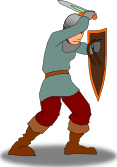
|
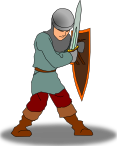
|

|
| healthy
If a healthy character is successfully attacked he becomes injured. |
injured
Injured characters have 1 subtracted from all of their rolls. If an injured character is successfully attacked he becomes incapacitated. If an injured character is healed he becomes healthy. |
incapacitated
Incapacitated characters can't do anything at all. If an incapacitated character is healed he becomes injured |
A successful fireball, similar magic spell or sneak attack (the first attack of a character with thievery ability) makes the target incapacitated regardless of their previous health.
Escaping[edit]
A character may want to flee rather than fight. This can be achieved two ways. First, before combat begins, a character can attempt to hide from other characters, using character levels added to the rolls (with an additional +1 for characters with thievery ability.) If a character successfully hides from the opposing characters, he does not have to participate in the following combat rounds.
Escaping after combat begins involves two steps: First, on the escaping character's turn, his player says that the character is trying to escape. This is the character's action for that turn. Second, on the escaping character's next turn, he disappears from combat if he has not been successfully attacked since the previous turn. Characters with thievery ability have a +1 bonus to defense rolls while they are trying to escape, and a +1 bonus to attack rolls when attacking a character who is trying to escape.
Extra Rules[edit]
Here is a section for adding extra rules that go beyond the absolutely essential "core rules".
Spells[edit]
Characters with magic ability can call their "fireball" spell anything they want, as long as it is incapacitating. For example, wizards might call their spell "freeze", "zap" or "choke". They might trap the enemy in a sticky web or turn him into a frog. Dragons might describe their spell as some kind of breath weapon, such as "acidic vomit" or "tear gas."
New Villains[edit]
New types of characters can have the same abilities as a monster, rogue, warrior, wizard, priest or dragon. Or you could give them a different combination of abilities. More powerful types of monsters should have higher levels. For example:
- Kraken
- The Kraken is a giant sea monster. The Kraken is a match for even famous heroes so it would have a level of 3 or 4. The Kraken has no special abilities.
- Leprechaun
- A leprechaun is a small, clever creature which is difficult to catch. Leprechauns have thievery ability and usually win contests of stealth and guile.
- Lich
- A lich is a powerful undead wizard with two abilities: In addition to the magic ability used to throw fireballs like a living wizard, the lich can raise fallen allies as undead servants like a sort of healing ability.
- Unicorn
- A unicorn is one of the most dangerous magical animals. Like the dragon it has all four abilities. It's horn has healing powers. This is the major reason people hunt unicorns, but the unicorn is clever and hard to catch because of it's thievery ability. The unicorn is so difficult to deceive that the standard strategy to catch the unicorn requires the use of an innocent girl without guile. The few warriors who have engaged unicorns in physical combat have been easily defeated by the unicorn's fighting ability often dispatched in a single blow by the magic horn.
New Abilities[edit]
Some characters might have minor abilities which give them just one aspect of the four basic abilities:
backstabbing (+1 to attack fleeing characters)
hiding (+1 to hide before combat)
pick locks (can try to pick locks)
disarm traps (can try to disarm traps)
initiative (go first in combat like characters with thievery)
sneak attack (attack on first turn can incapacitate a healthy enemy)
fireball (just the spell without the magic knowledge)
arcane lore (just the knowledge without the spell)
attacking (+1 to attack rolls)
defending (+1 to defense rolls)
revive (change an incapacitated ally's health to injured.)
heal wounds (change an injured ally's health to healthy.)
persuasion (+1 to people skills)
Characters could also have abilities which have different effects:
- protection ability gives the character uncanny ability to avoid assassination attempts and magical curses. A character with protection ability is injured instead of incapacitated by a successful fireball, other spell or sneak attack.
- explosion ability allows a character to cast a spell which hits every enemy in a battle. When the character uses this spell, make an attack roll against every enemy which is not incapacitated. If the roll is successful the enemy is injured if it was healthy and incapacitated if it was injured. Unlike fireball and similar spells, explosion spells do not incapacitate healthy enemies.
Characters can even have disabilities that work against them:
- vampirism gives the character an unquenchable thirst for blood and an allergy to sunlight, religion and spicy foods.
- unclean abomination disability causes the character with the disability to be incapacitated by any successful attack from a character with healing ability, such as a priest, even if the character with this disability is healthy.
Items[edit]
Most equipment, such as swords, armor, invisibility cloaks and magic wands simply make characters better at doing the things they can already do. This is reflected in the character's level. However, sometimes characters may have the need or opportunity to use items that enable them to do new things. These might be permanent things the character can use over and over, or they might be items which are only used once. For example:
- a flying carpet allows a small group of characters to fly
- a healing potion allows any character to heal like a Priest, but after one use the healing potion is gone
- a ninja smoke bomb is a single-use item which allows a character to escape instantly instead of giving his attackers a chance to catch him.
- a protective amulet gives the character wearing it the protection ability.
- a destruction scroll gives the explosion ability to any character with magic ability who studies the scroll for a few days (the character keeps the explosion ability even if they lose the scroll.)
Minions[edit]
Some villains surround themselves with armies of evil but not particularly powerful minions, which are easy for heroes to kill except for their numbers. Minions are always level 0 and have no special abilities. Minions are even easier to kill than level 0 monsters and villagers with no special abilities: any successful attack against a minion will incapacitate it, even if the minion is not injured. (Other types of character might also have this weakness, like helpless people and small animals.)
Traps[edit]
Characters can set traps and ambush their opponents. The characters who set the trap must stay with the trap and wait for their opponents to walk into it, or the trap will have no effect.
Characters with thievery ability have a chance to detect a trap before walking into it. Roll a die for each character with thievery heading toward the trap and add their level to the result. Roll another die for the trap and add the highest level of any character with thievery ability who helped set the trap to that roll. If the roll for the trap is equal to or greater than the rolls for all of the characters with thievery heading for the trap, then the characters who set the trap and are waiting in ambush get one turn to attack or flee before combat begins normally.
If any character with thievery heading toward the ambush rolls higher than the roll for the trap, he detects the trap. All of the characters on his side can avoid the trap and the characters waiting in ambush, or they can choose to fight the characters waiting in ambush. When characters detect a trap and avoid it, they don't get to find out how many and what type of enemies were lying in wait.
More Levels[edit]
For more gradual character development you can allow higher maximum levels and increase the ability and injury modifiers from +1 or -1 to +3 or -3. Use a 20 sided die instead of a 6 sided die for attack rolls, and add 10 to the defender's level and modifiers instead of a defense roll.
For other rolls use a 20 sided die instead of a 6 sided die for one side and 10 instead of a die roll for the other side. Although it does not make a big difference, the die should usually be rolled for the side playing a more "active" role, and the 10 should be added to the side that represents the difficulty of that action. When this is unclear roll the die for the players' side and add 10 for the Game Master's side.
Original Mano a Mano[edit]
If you would like something more detailed than mini mam which allows for more customized characters and combat options, check out Mano a Mano.
